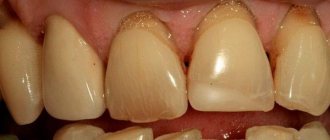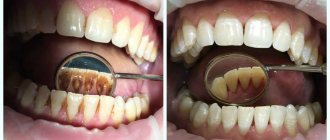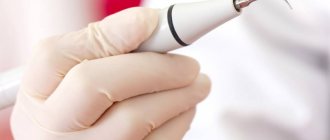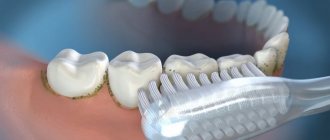Is it possible to remove tartar at home?
In the presence of dense and old deposits, effective removal of tartar at home is almost impossible. The most complex is considered to be subgingival tartar, which forms in periodontal pockets. In this case, contacting a hygienist is mandatory.
Of course, with due effort it is possible to remove the top layer of hard supragingival deposits, but its complete removal is only possible with the help of special equipment in the dental hygienist’s office. When the plaque is in the initial stage of hardening or has a loose structure, it can be quite successfully dealt with at home. It’s easier to do prevention than to deal with the consequences.
Choosing the right brush is already half the battle
When hard plaque appears on your teeth, you need to approach the choice of brush very responsibly. What parameters should it have?
- Be multi-tufted with rounded edges and man-made fibres.
- Have a small nozzle.
- Have medium hard bristles.
Electric and ultrasonic brushes get good reviews.
Electric brushes make a large number of movements in one minute. With the help of pulsation, partially mineralized plaque is broken up.
Ultrasonic brushes have a specially built-in generator that generates oscillatory ultrasound waves. They can remove small hard deposits.
How to remove tartar at home?
No matter how trivial it may sound, cleaning tartar at home is carried out with ordinary hygiene products: toothpaste, brush and irrigator.
- Toothpaste. For more or less effective removal of tartar, you need high-quality toothpaste with high abrasiveness (with an RDA coefficient of 120). Such products contain solid microparticles, most often silicon dioxide or aluminum oxide. Abrasive toothpastes do a good job of removing loose plaque and are even able to clean loose hard deposits, but at the same time they cause damage to the enamel. They are not suitable for people with sensitive teeth. This is especially true for tooth powder, which often appears in lists of tips on how to get rid of tartar at home. It should be used with extreme caution as it contains a large number of aggressive abrasive elements.
- Toothbrush. To quickly remove tartar at home, while its layer has not yet become thick, you need to use a toothbrush with the hardest bristles. This option is not suitable for everyone, since intensive cleaning causes the bristles to injure the enamel and gums. A good ultrasonic toothbrush would be ideal.
- Irrigator. A jet of water (even at high intensity) is not capable of destroying hard tartar, but it does a very good job of removing loose plaque. An irrigator is strictly recommended if you want to get rid of tartar at home, since it effectively cleans the most inaccessible areas of the oral cavity.
Step-by-step instruction
Cleaning steps
So, what does peroxide give us if it is applied to the surface of a tooth with pronounced plaque:
- The process of oxidation of stones occurs, they become loose.
- Completely suppresses bacterial flora, strengthening soft tissues.
- Does not destroy enamel, does not remove minerals from its composition.
Removing tartar with hydrogen peroxide has its own nuances that should be observed:
- Use only 3% peroxide, as higher concentrations can cause burns to the mucous membrane.
- Never use this product in its pure form. Always dilute with water.
- While fighting tartar, avoid eating sweets, coffee and black tea.
- After cleaning, it is not recommended to drink or eat for about 2 hours.
Remember that the process of dealing with persistent plaque does not mean rinsing your mouth with peroxide once. The process is long, but the result will exceed all your expectations, believe me.
Cleaning tartar with hydrogen peroxide is carried out in several stages:
- Applications - dilute 1 tablespoon of hydrogen peroxide and half of clean warm water in a glass container. Soak a cotton pad in the resulting liquid and apply to problem areas. Leave for 10 minutes, while using your hands to firmly press the disc against the gum area. After 10 minutes, the mouth should be rinsed with warm water. Applications are carried out daily for 5-7 days.
- Mouth rinse - dissolve 3 tablespoons of peroxide in half a glass of warm water. Rinse your mouth after every meal for a week.
- Abrasive cleaning is the final stage, when it is already possible to trace positive dynamics, but not all of the deposits have gone away. You need to apply a few drops of peroxide to a hard toothbrush and thoroughly brush all your teeth.
Usually this sequence of actions is enough to dissolve plaque and make your teeth as snow-white as possible.
Precautionary measures
When we remove tartar with hydrogen peroxide, we get not only a new smile, but also health. Everything that is done should be related primarily to oral health, and then to aesthetics. Peroxide allows you to remove harmful bacteria without disturbing the natural balance of microflora. To avoid any problems when using this method of fighting tartar, always follow these precautions:
- Do not swallow peroxide as it may cause stomach pain and discomfort.
- Do not use the method if your gums are bleeding excessively, or if you have progressive periodontal disease.
- Always pay attention to how you feel after the procedure. If there are no unpleasant sensations, then continue fighting the stone.
Experts do not recommend using peroxide for longer than 7 days. If it was not possible to remove the stone during this time (this happens with long-term persistent deposits), then the problem should be solved together with the dentist.
If pain, discomfort, or ulceration of the mucous membrane occurs, the use of peroxide should be discontinued immediately. Don't think that the more you apply to your tooth, the whiter it will be. This doesn't work because color is formed from a number of internal factors.
The most important advice that you must learn: peroxide is not a panacea! If you have serious problems with your teeth, or there are acute and chronic infectious and inflammatory processes in the oral cavity, then it is better to immediately contact a specialist and not self-medicate. While you are hoping for peroxide, time is ticking. If there are no noticeable results, and the condition of your teeth is only worsening, then, unfortunately, you cannot do without a doctor.
Lemon, celandine and soda
On the Internet you can find many articles with headings from the series “how to clean tartar at home” or “how to dissolve tartar at home.” In these materials you can find dozens of “one hundred percent” recipes that will miraculously help get rid of tartar. In fact, all this is a myth. No traditional medicine can effectively remove hard dental plaque. Moreover, most of these tinctures and decoctions can also cause harm. For example, a decoction of celandine (often recommended) is poisonous and can cause poisoning. Lemon juice, which is a component of most of these recipes, contains acid, which is generally harmful to dental tissue and is ineffective at removing hard deposits.
To summarize, there is more harm from such recipes than good. The only more or less effective remedy, whose chemical properties help to somehow break down small dental deposits, is a solution of soda and hydrogen peroxide. At the same time, the same peroxide (especially if you make a mistake with the proportions) can cause serious harm to the enamel, so you can use it only at your own peril and risk.
How to remove plaque from a removable denture
Removable dentures, like your own teeth, require constant care and regular cleaning of plaque and food debris. Experts recommend cleaning the orthopedic device twice a day, and antiseptic treatment at least once a week. To do this, it is best to take baths with a special antibacterial solution, which can be purchased at any pharmacy. Traditional medicine offers its own version of cleaning the prosthesis:
- take white vinegar and mix it with water in equal proportions,
- place the prosthesis in a container with the resulting solution, leave the product there for several hours or even overnight,
- Remove the structure from the bath, carefully inspect it and, if there are any remaining stains, thoroughly clean them with a soft-bristled brush.
Vinegar diluted in water will help remove plaque from the prosthesis.
To maintain hygiene, it is also recommended to use an irrigator. This device does not replace a brush, but is an effective additional tool for keeping teeth and orthopedic systems clean.
Prevention of tartar
This article is entirely devoted to how to remove tartar at home, but it is also important to talk about how to prevent its occurrence. Prevention of dental plaque includes comprehensive and regular oral hygiene. Tartar builds up in hard-to-reach places, so use floss, irrigators and mouth rinses if you want to minimize the risk of plaque mineralization. Another important point is nutrition. Foods high in carbohydrates and dyes accelerate the formation of tartar. The same applies to tobacco: do you want to have healthy and snow-white teeth? Stop smoking. Well, if you do notice the first signs of tartar formation, consult a doctor. Professional cleaning and saturation of the enamel with useful minerals will restore your snow-white smile.
Symptoms signaling the formation of hard deposits
There are certain signs that indicate the beginning of the formation of tartar. It is important to know these symptoms so that you can recognize the problem in time and seek appropriate help. Here are the main ones:
- dark pigmented areas that first appear on the inside of the row, but gradually move to the front side,
- bad breath,
- redness or even blueness of the gums,
- the appearance of bleeding, especially during cleaning,
- inflammation of the mucous membrane, itching and soreness - in advanced cases, in the presence of subgingival deposits.
Bad breath may indicate a problem.
First, the stone forms at the neck of the tooth, surrounding it with a dark rim. Gradually it spreads into the subgingival area and covers an increasingly larger area of the coronal part.
How does soda work?
Soda powder has a fine-grained structure, due to which it gently cleanses and destroys tartar. Thanks to its alkaline effect, sodium bicarbonate changes the chemical nature of solid deposits, and due to its abrasive properties, it removes them layer by layer.
On a note. Some professional dental cleaning powders contain from 20 to 50% baking soda.
In addition, sodium bicarbonate improves the condition of the oral cavity:
- Increases the pH of saliva, neutralizing the aggressive effects of organic acids on teeth.
- Gently polishes the enamel, giving it a lighter tone.
- Prevents the formation of plaque, which increases the absorption of minerals from saliva by dental tissue.
Effective recipes
Dry soda
The use of dry powder is considered one of the most aggressive methods of sanitation of the oral cavity using soda. A small amount is applied to the surface of the teeth and rubbed thoroughly.
Attention! When applying sodium bicarbonate in any form to tooth enamel, do not use a toothbrush. It is acceptable to use cotton swabs, gauze swabs and turundas.
Concentrated solution
Add soda in small portions to a small amount of water and mix thoroughly. As soon as the powder stops dissolving, the concentrate is ready. Use the resulting liquid to brush your teeth, then rinse your mouth with clean water.
Using foil
To increase the duration of exposure of the soda to the teeth, use foil. Two strips are made from it, onto which a mixture of soda and toothpaste is placed, after which they are wrapped around the upper and lower row of teeth. These foil mouthguards are left in the mouth for 1 hour, then removed and rinsed with clean water.
This method can be used once a week.
Enrichment of toothpaste
Add a pinch of soda to any toothpaste immediately before brushing your teeth. But for maximum enamel protection, it is better to use a fluoride-containing paste with a fluoride concentration of at least 1400 ppm.
Reference. In this case, using a toothbrush is acceptable, but preferably with soft bristles.
With salt
Soda is mixed with dry salt in a 1:1 ratio and a little water is added until a paste is obtained. Use the prepared mixture to brush your teeth 1–2 times a week until the desired effect is achieved.
With iodine
Dissolve 1 tsp in a glass of warm water. soda and add 1 drop of iodine. Rinse your mouth with this solution after each brushing of your teeth.
With hydrogen peroxide
Attention! Hydrogen peroxide is considered an aggressive solution for teeth and oral cavity. Therefore, the product is used no more than once a month.
A small amount of a 3% solution is mixed with soda to form a thick paste, which is rubbed into the enamel for 2 minutes. Then rinse with water.
Carefully! In case of contact with the gums, a burn of the mucous membrane with lightening of the surface is possible. In such a situation, it is necessary to stop the procedure and rinse off the product with clean water.
With fruit acids
Fruit acids enhance the cleansing effect of soda and also lighten the tone of the enamel. Lemon is best suited for these purposes, but you can use grapefruit and kiwi.
Add a few drops of sour fruit juice to the dry powder and rub the teeth for 1 minute. The procedure is repeated no more than 1–2 times a month.
Remember. The mixture with acids has a very aggressive effect on the teeth; frequent use can damage the enamel.
With strawberry
Strawberries have whitening properties, so they are used not only in cosmetology, but also to lighten tooth enamel.
The pulp of fresh berries is mashed, a pinch of soda is added and the teeth are rubbed. This composition is kept in the mouth for 2-3 minutes.
With activated carbon
An activated carbon tablet is crushed to a powder and mixed with soda 1:1. Dip a toothbrush into the resulting mixture and brush your teeth for 1–2 minutes. After this, rinse your mouth with clean water.
This cleaning is used 1-2 times a week.
Attention! Charcoal can stain dentures, crowns and fillings.
Reviews
Christina. I really like drinking coffee. Because of this, pigmented plaque appears on the teeth. I started brushing my teeth with dry soda powder every day for 1.5 weeks. The result is positive: the teeth are lightened and the plaque is gone. No sensitivity was evident.
Natalia. I used activated carbon. There is an effect, but it is insignificant. I haven’t observed any negative effects, so I use it sometimes.
Olga. I brushed my teeth with baking soda for 2 weeks in a row. The plaque has partially disappeared, but the stones remain in place, and the enamel is still yellow. I don't recommend it.
Vladimir. After using baking soda with lemon, severe tooth sensitivity appeared. Now I can’t eat anything cold or sour. I don’t recommend it to anyone, it’s better to go to the dentist.
Preventive measures
The best prevention in this case would be a systematic visit to the dentist for professional cleaning. Experts in the field of dentistry and hygiene recommend undergoing the procedure at least once every six months. If the patient smokes or often drinks coffee and strong tea, prof. hygiene every 4 months, but on this matter you need to consult with your doctor - it all depends on the current condition of the enamel and its individual characteristics.
Proper dental hygiene is important to maintain your smile.
As mentioned above, you should periodically use an ultrasonic or electric brush, as well as a special abrasive paste with an RDA index above 1202 - this indicator will be indicated on the packaging. Just remember that you cannot constantly use such a product, as it can harm the enamel layer. It is better to alternate it with fluoride-containing and regular prophylactic paste. You also need to remember to use floss, rinse your mouth every time after eating, and it is better to purchase an irrigator to clean the interdental spaces and hard-to-reach places. It is recommended to consume hard vegetables and fruits more often - the moment you bite into an apple or, for example, a carrot, natural plaque is removed from the enamel
Removing stones at home
Today you can read various recipes online, following which, it seems, you can cleanse your teeth of unwanted formations without the help of a specialist. In addition to the fact that they will not bring the desired effect, such methods can additionally injure the teeth and cause additional harm to them. The use of soda or mineralized salt is not considered the best folk remedies. Cleaning teeth from stones is the task of professionals in their field. The only thing you can do is to follow preventive measures and prevent stones from appearing.
Folk remedies or professional hygiene
Not many people carefully monitor the condition of their teeth, and therefore most patients find out about the presence of tartar only at an appointment with the dentist. By this point, the deposits usually completely harden, and it becomes impossible to cope with them on your own. In such a situation, there is only one way out - sign up for a professional cleaning with a dentist. But in fact, this is the best option, the most effective and safe.
You can remove semi-hardened plaque at home using abrasives and electric brushes, but in this case there is always a risk of damaging the enamel. It is better if this issue is dealt with by an experienced professional who will immediately assess the condition of your teeth and gums and will also be able to remove tartar carefully, from all hard-to-reach places and with a guarantee of safety for your smile.










